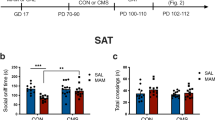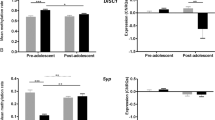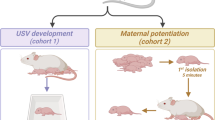Abstract
Although numerous studies have implicated stress in the pathophysiology of schizophrenia, less is known about how the effects of stress interact with genetic, developmental, and/or environmental determinants to promote disease progression. In particular, it has been proposed that in humans, stress exposure in adolescence could combine with a predisposition towards increased stress sensitivity, leading to prodromal symptoms and eventually psychosis. However, the neurobiological substrates for this interaction are not fully characterized. Previous work in our lab has demonstrated that rats born to dams administered with the DNA-methylating agent methylazoxymethanol acetate (MAM) at gestational day 17 exhibit as adults behavioral and anatomical abnormalities consistent with those observed in patients with schizophrenia. Here, we examined behavioral and neuroendocrine responses to stress in the MAM model of schizophrenia. MAM-treated male rats were exposed to acute and repeated footshock stress at prepubertal, peripubteral, and adult ages. Ultrasonic vocalizations (USVs), freezing, and corticosterone responses were quantified. We found that juvenile MAM-treated rats emitted significantly more calls, spent more time vocalizing, emitted calls at a higher rate, and showed more freezing in response to acute footshock stress when compared with their saline (SAL) treated counterparts, and that this difference is not present in older animals. In addition, adolescent MAM-treated animals displayed a blunted HPA axis corticosterone response to acute footshock that did not adapt after 10 days of stress exposure. These data demonstrate abnormal stress responsivity in the MAM model of schizophrenia and suggest that these animals are more sensitive to the effects of stress in youth.
Similar content being viewed by others
Log in or create a free account to read this content
Gain free access to this article, as well as selected content from this journal and more on nature.com
or
References
Addington J, Heinssen R (2012). Prediction and prevention of psychosis in youth at clinical high risk. Annu Rev Clin Psychol 8: 269–289.
Baker DG, Ekhator NN, Kasckow JW, Dashevsky B, Horn PS, Bednarik L et al (2005). Higher levels of basal serial CSF cortisol in combat veterans with posttraumatic stress disorder. Am J Psychiatry 162: 992–994.
Belujon P, Grace AA (2011). Hippocampus, amygdala, and stress: interacting systems that affect susceptibility to addiction. Ann N Y Acad Sci 1216: 114–121.
Belujon P, Patton MH, Grace AA (2013). Role of the prefrontal cortex in altered hippocampal-accumbens synaptic plasticity in a developmental animal model of schizophrenia. Cerebral Cortex (doi:10.1093/cercor/bhs380).
Benes F (1997). The role of stress and dopamine-GABA interactions in the vulnerability for schizophrenia. J Psychiatr Res 31: 257–275.
Berretta S, Munno DW, Benes FM (2001). Amygdalar activation alters the hippocampal GABA system: “partial” modelling for postmortem changes in schizophrenia. J Comp Neurol 431: 129–138.
Brudzynski SM (2001). Pharmacological and behavioral characteristics of 22 kHz alarm calls in rats. Neurosci Biobehav Rev 25: 611–617.
Brudzynski SM, Holland G (2005). Acoustic characteristics of air puff-induced 22-kHz alarm calls in direct recordings. Neurosci Biobehav Rev 29: 1169–1180.
Chance SA, Esiri MM, Crow TJ (2002). Amygdala volume in schizophrenia: post-mortem study and review of magnetic resonance imaging findings. Br J Psychiatry 180: 331–338.
Chrapusta SJ, Egan MF, Wyatt RJ, Weinberger DR, Lipska BK (2003). Neonatal ventral hippocampal damage modifies serum corticosterone and dopamine release responses to acute footshock in adult Sprague-Dawley rats. Synapse 47: 270–277.
Clinton S, Miller S, Watson SJ, Akil H (2008). Prenatal stress does not alter innate novelty-seeking behavioral traits, but differentially affects individual differences in neuroendocrine stress responsivity. Psychoneuroendocrinology 33: 162–177.
Corcoran C, Walker E, Huot R, Mittal V, Tessner K, Kestler L et al (2003). The stress cascade and schizophrenia: etiology and onset. Schizophr Bull 29: 671–692.
Del Punta K, Leinders-Zufall T, Rodriguez I, Jukam D, Wysocki CJ, Ogawa S et al (2002). Deficient pheromone responses in mice lacking a cluster of vomeronasal receptor genes. Nature 419: 70–74.
Dess N, Minor T (1989). Suppression of feeding and body weight by inescapable shock: modulation by quinine adulteration, stress reinstatement, and controllability. Physiol Behav 45: 975–983.
Dias-Ferreira E, Sousa J, Melo I, Morgado P (2009). Chronic stress causes frontostriatal reorganization and affects decision-making. Science 325: 621–625.
Drugan RC, Christianson JP, Stine WW, Soucy DP (2009). Swim stress-induced ultrasonic vocalizations forecast resilience in rats. Behav Brain Res 202: 142–145.
Du Y, Grace AA (2013). Peripubertal diazepam prevents the emergence of dopamine hyper-responsivity in the MAM model of schizophrenia. Neuropsychopharmacology (doi:10.1038/npp.2013.101).
Finlay JM, Zigmond MJ, Abercrombie ED (1995). Increased dopamine and norepinephrine release in medial prefrontal cortex induced by acute and chronic stress: effects of diazepam. Neuroscience 64: 619–628.
Flagstad P, Mørk A, Glenthøj BY, van Beek J, Michael-Titus AT, Didriksen M (2004). Disruption of neurogenesis on gestational day 17 in the rat causes behavioral changes relevant to positive and negative schizophrenia symptoms and alters amphetamine-induced dopamine release in nucleus accumbens. Neuropsychopharmacology 29: 2052–2064.
Goto Y, Grace AA (2006). Alterations in medial prefrontal cortical activity and plasticity in rats with disruption of cortical development. Biol Psychiatry 60: 1259–1267.
Grace AA (2004). Developmental dysregulation of the dopamine system and the pathophysiology of schizophrenia. In: Keshavan M, Kennedy JL, Murray RM (eds). Neurodevelopment and Schizophrenia. Cambridge University Press. pp 273–294.
Grace AA (2010). Dopamine system dysregulation by the ventral subiculum as the common pathophysiological basis for schizophrenia psychosis, psychostimulant abuse, and stress. Neurotox Res 18: 367–376.
Grace AA, Moore H (1998) Regulation of information flow in the nucleus accumbens: A model for the pathophysiology of schizophrenia. American Psychological Association: Washington, DC, USA. pp 123–157.
Hariri AR, Mattay VS, Tessitore A, Fera F, Weinberger DR (2003). Neocortical modulation of the amygdala response to fearful stimuli. Biol Psychiatr 53: 494–501.
Jankord R, Herman JP (2008). Limbic regulation of hypothalamo-pituitary-adrenocortical function during acute and chronic stress. Ann N Y Acad Sci 1148: 64–73.
Johnstone EC, Lawrie SM, Cosway R (2002). What does the Edinburgh high-risk study tell us about schizophrenia? Am J Med Genet 114: 906–912.
Kim EJ, Kim ES, Covey E, Kim JJ (2010). Social transmission of fear in rats: the role of 22-kHz ultrasonic distress vocalization. PLoS ONE 5: e15077.
Knable MB, Weinberger DR (1997). Dopamine, the prefrontal cortex and schizophrenia. J Psychopharmacol 11: 123–131.
Kosten TA, Miserendino MJD, Bombace JC, Lee HJ, Kim JJ (2005). Sex-selective effects of neonatal isolation on fear conditioning and foot shock sensitivity. Behav Brain Res 157: 235–244.
LaBar KS, Cabeza R (2006). Cognitive neuroscience of emotional memory. Nat Rev Neurosci 7: 54–64.
Le Pen G, Gourevitch R, Hazane F, Hoareau C, Jay TM, Krebs M-O (2006). Peri-pubertal maturation after developmental disturbance: a model for psychosis onset in the rat. Neuroscience 143: 395–405.
Lewis DA, Hashimoto T, Volk DW (2005). Cortical inhibitory neurons and schizophrenia. Nat Rev Neurosci 6: 312–324.
Lightman SL, Wiles CC, Atkinson HC, Henley DE, Russell GM, Leendertz JA et al (2008). The significance of glucocorticoid pulsatility. Eur J Pharmacol 583: 255–262.
Lim C, Chong S (2009). Psychosocial factors in the neurobiology of schizophrenia: a selective review. Ann Acad Med Singapore 38: 402–406.
Lisman JE, Pi HJ, Zhang Y, Otmakhova NA (2010). A thalamo-hippocampal-ventral tegmental area loop may produce the positive feedback that underlies the psychotic break in schizophrenia. Biol Psychiatr 68: 17–24.
Lodge DJ, Grace AA (2007). Aberrant hippocampal activity underlies the dopamine dysregulation in an animal model of schizophrenia. J Neurosci 27: 11424–11430.
Lodge DJ, Grace AA (2008). Hippocampal dysfunction and disruption of dopamine system regulation in an animal model of schizophrenia. Neurotox Res 14: 97–104.
Luo H, Hu X, Liu X, Ma X, Guo W, Qiu C et al (2012). Hair cortisol level as a biomarker for altered hypothalamic-pituitary-adrenal activity in female adolescents with posttraumatic stress disorder after the 2008 Wenchuan earthquake. Biol Psychiatr 72: 65–69.
McEwen BS (2007). Physiology and neurobiology of stress and adaptation: central role of the brain. Physiol Rev 87: 873–904.
McEwen BS, Gianaros PJ (2010). Central role of the brain in stress and adaptation: links to socioeconomic status, health, and disease. Ann N Y Acad Sci 1186: 190–222.
Meyer-Lindenberg A, Tost H (2012). Neural mechanisms of social risk for psychiatric disorders. Nat Neurosci 15: 663–668.
Miller P, Lawrie SM, Hodges A, Clafferty R, Cosway R, Johnstone EC (2001). Genetic liability, illicit drug use, life stress and psychotic symptoms: preliminary findings from the Edinburgh study of people at high risk for schizophrenia. Soc Psychiatr Psychiatr Epidemiol 36: 338–342.
Moore H, Jentsch JD, Ghajarnia M, Geyer MA, Grace AA (2006). A neurobehavioral systems analysis of adult rats exposed to methylazoxymethanol acetate on E17: implications for the neuropathology of schizophrenia. Biol Psychiatry 60: 253–264.
Nagata Y, Matsumoto H (1969). Studies on methylazoxymethanol: methylation of nucleic acids in the fetal rat brain. Proc Soc Exp Biol Med 132: 383.
Owens DGC, Miller P, Lawrie SM, Johnstone EC (2005). Pathogenesis of schizophrenia: a psychopathological perspective. Br J Psychiatr 186: 386–393.
Phillips LK, Seidman LJ (2008). Emotion processing in persons at risk for schizophrenia. Schizophr Bull 34: 888–903.
Portfors CV (2007). Types and functions of ultrasonic vocalizations in laboratory rats and mice. J Am Assoc Lab Anim Sci 46: 28–34.
Rao RP, Anilkumar S, McEwen BS, Chattarji S (2012). Glucocorticoids protect against the delayed behavioral and cellular effects of acute stress on the amygdala. Biol Psychiatr 72: 466–475.
Roozendaal B, McEwen BS, Chattarji S (2009). Stress, memory and the amygdala. Nat Rev Neurosci 10: 423–433.
Schwarting RKW, Wöhr M (2012). On the relationships between ultrasonic calling and anxiety-related behavior in rats. Braz J Med Biol Res 45: 337–348.
Thompson JL, Pogue-Geile MF, Grace AA (2004). Developmental pathology, dopamine, and stress: a model for the age of onset of schizophrenia symptoms. Schizophr Bull 30: 875–900.
Touma C (2011). Stress and affective disorders: animal models elucidating the molecular basis of neuroendocrine-behavior interactions. Pharmacopsychiatry 44: S15–S26.
Tsuang M (2000). Schizophrenia: genes and environment. Biol Psychiatr 47: 210–220.
Walker E, Mittal V, Tessner K (2008). Stress and the hypothalamic pituitary adrenal axis in the developmental course of schizophrenia. Annu Rev Clin Psychol 4: 189–216.
Walker EF, Sabuwalla Z, Huot R (2004). Pubertal neuromaturation, stress sensitivity, and psychopathology. Dev Psychopathol 16: 807–824.
Williams AM, Reis DJ, Powell AS, Neira LJ, Nealey KA, Ziegler CE et al (2012). The effect of intermittent alcohol vapor or pulsatile heroin on somatic and negative affective indices during spontaneous withdrawal in Wistar rats. Psychopharmacology 223: 75–88.
Acknowledgements
This work was funded by NIH MH57440. The authors would like to thank all members of the Grace lab for their helpful input and advice.
Author information
Authors and Affiliations
Corresponding author
Rights and permissions
About this article
Cite this article
Zimmerman, E., Bellaire, M., Ewing, S. et al. Abnormal Stress Responsivity in a Rodent Developmental Disruption Model of Schizophrenia. Neuropsychopharmacol 38, 2131–2139 (2013). https://doi.org/10.1038/npp.2013.110
Received:
Revised:
Accepted:
Published:
Issue date:
DOI: https://doi.org/10.1038/npp.2013.110
Keywords
This article is cited by
-
Threat Responses in Schizophrenia: A Negative Valence Systems Framework
Current Psychiatry Reports (2024)
-
Adult stress exposure blunts dopamine system hyperresponsivity in a neurodevelopmental rodent model of schizophrenia
Schizophrenia (2022)
-
Thalamic reticular nucleus impairments and abnormal prefrontal control of dopamine system in a developmental model of schizophrenia: prevention by N-acetylcysteine
Molecular Psychiatry (2021)
-
Reduced cortical GABA and glutamate in high schizotypy
Psychopharmacology (2021)
-
Corticolimbic hyper-response to emotion and glutamatergic function in people with high schizotypy: a multimodal fMRI-MRS study
Translational Psychiatry (2017)



